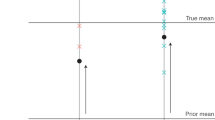Abstract
It is fair to say that many of the prominent examples of bias in Machine Learning (ML) arise from bias in the training data. In fact, some would argue that supervised ML algorithms cannot be biased, they reflect the data on which they are trained. In this paper, we demonstrate how ML algorithms can misrepresent the training data through underestimation. We show how irreducible error, regularization, and feature and class imbalance can contribute to this underestimation. The paper concludes with a demonstration of how the careful management of synthetic counterfactuals can ameliorate the impact of this underestimation bias.
Access this chapter
Tax calculation will be finalised at checkout
Purchases are for personal use only
Similar content being viewed by others
References
Adler, P., et al.: Auditing black-box models for indirect influence (2016)
Bender, E.M., Gebru, T., McMillan-Major, A., Shmitchell, S.: On the dangers of stochastic parrots: can language models be too big? In: Proceedings of the 2021 ACM Conference on Fairness, Accountability, and Transparency, pp. 610–623. FAccT 2021. Association for Computing Machinery, New York, NY, USA (2021)
Caton, S., Haas, C.: Fairness in machine learning: a survey. arXiv preprint arXiv:2010.04053 (2020)
Chawla, N.V., Bowyer, K.W., Hall, L.O., Kegelmeyer, W.P.: SMOTE: synthetic minority over-sampling technique. J. Artif. Int. Res. 16(1), 321–357 (2002)
Corbett-Davies, S., Goel, S.: The measure and mismeasure of fairness: a critical review of fair machine learning (2018)
Cunningham, P., Delany, S.J.: Algorithmic bias and regularisation in machine learning. arXiv preprint arXiv:2005.09052 (2020)
Dressel, J., Farid, H.: The accuracy, fairness, and limits of predicting recidivism. Sci. Adv. 4(1), eaao5580 (2018)
Dunkelau, J., Leuschel, M.: Fairness-aware machine learning (2019)
Feldman, M., Friedler, S.A., Moeller, J., Scheidegger, C., Venkatasubramanian, S.: Certifying and removing disparate impact. In: proceedings of the 21th ACM SIGKDD International Conference on Knowledge Discovery and Data Mining, pp. 259–268 (2015)
Ginsberg, M.L.: Counterfactuals. Artif. Intell. 30(1), 35–79 (1986)
Guo, X., Yin, Y., Dong, C., Yang, G., Zhou, G.: On the class imbalance problem. In: 2008 Fourth International Conference on Natural Computation, vol. 4, pp. 192–201 (2008)
Hardt, M., Price, E., Srebro, N.: Equality of opportunity in supervised learning. In: Proceedings of the 30th International Conference on Neural Information Processing Systems, pp. 3323–3331. NIPS 2016, Curran Associates Inc., NY, USA (2016)
Hoerl, A.E., Kennard, R.W.: Ridge regression: biased estimation for nonorthogonal problems. Technometrics 12(1), 55–67 (1970)
Hooker, S., Courville, A., Clark, G., Dauphin, Y., Frome, A.: What do compressed deep neural networks forget? (2020)
Hooker, S., Moorosi, N., Clark, G., Bengio, S., Denton, E.: Characterising bias in compressed models. arXiv e-prints pp. arXiv-2010 (2020)
Kamiran, F., Calders, T.: Data pre-processing techniques for classification without discrimination. Knowl. Inf. Syst. 33, 1–33 (2011). https://doi.org/10.1007/s10115-011-0463-8
Kamishima, T., Akaho, S., Asoh, H., Sakuma, J.: Fairness-aware classifier with prejudice remover regularizer. In: Flach, P.A., De Bie, T., Cristianini, N. (eds.) ECML PKDD 2012. LNCS (LNAI), vol. 7524, pp. 35–50. Springer, Heidelberg (2012). https://doi.org/10.1007/978-3-642-33486-3_3
Keane, M.T., Smyth, B.: Good counterfactuals and where to find them: a case-based technique for generating counterfactuals for explainable AI (XAI). In: International Conference on Case-Based Reasoning, pp. 163–178. Springer (2020)
Kohavi, R.: Scaling up the accuracy of Naive-Bayes classifiers: a decision-tree hybrid. In: Proceedings of the Second International Conference on Knowledge Discovery and Data Mining, vol. 96, pp. 202–207 (1996)
Kubat, M., Holte, R.C., Matwin, S.: Machine learning for the detection of oil spills in satellite radar images. Mach. Learn. 30(2), 195–215 (1998)
Kusner, M.J., Loftus, J., Russell, C., Silva, R.: Counterfactual fairness. In: Guyon, I., et al. (eds.) Advances in Neural Information Processing Systems, vol. 30. Curran Associates, Inc. (2017)
Mac Namee, B., Cunningham, P., Byrne, S., Corrigan, O.I.: The problem of bias in training data in regression problems in medical decision support. Artif. Intell. Med. 24(1), 51–70 (2002)
Thodberg, H.H.: Improving generalization of neural networks through pruning. Int. J. Neural Syst. 01(04), 317–326 (1991)
Tumer, K., Ghosh, J.: Estimating the Bayes error rate through classifier combining. In: Proceedings of 13th International Conference on Pattern Recognition, vol. 2, pp. 695–699. IEEE (1996)
Weiss, G.M.: Mining with rarity: a unifying framework. SIGKDD Explor. Newsl. 6(1), 7–19 (2004)
Žliobaitė, I.: Measuring discrimination in algorithmic decision making. Data Mining Knowl. Discovery 31(4), 1060–1089 (2017)
Žliobaitė, I., Custers, B.: Using sensitive personal data may be necessary for avoiding discrimination in data-driven decision models. Artif. Intell. Law 24(2), 183–201 (2016)
Acknowledgements
This work was funded by Science Foundation Ireland through the SFI Centre for Research Training in Machine Learning (Grant No. 18/CRT/6183) with support from Microsoft Ireland.
Author information
Authors and Affiliations
Corresponding author
Editor information
Editors and Affiliations
Rights and permissions
Copyright information
© 2021 Springer Nature Switzerland AG
About this paper
Cite this paper
Blanzeisky, W., Cunningham, P. (2021). Algorithmic Factors Influencing Bias in Machine Learning. In: Kamp, M., et al. Machine Learning and Principles and Practice of Knowledge Discovery in Databases. ECML PKDD 2021. Communications in Computer and Information Science, vol 1524. Springer, Cham. https://doi.org/10.1007/978-3-030-93736-2_41
Download citation
DOI: https://doi.org/10.1007/978-3-030-93736-2_41
Published:
Publisher Name: Springer, Cham
Print ISBN: 978-3-030-93735-5
Online ISBN: 978-3-030-93736-2
eBook Packages: Computer ScienceComputer Science (R0)




